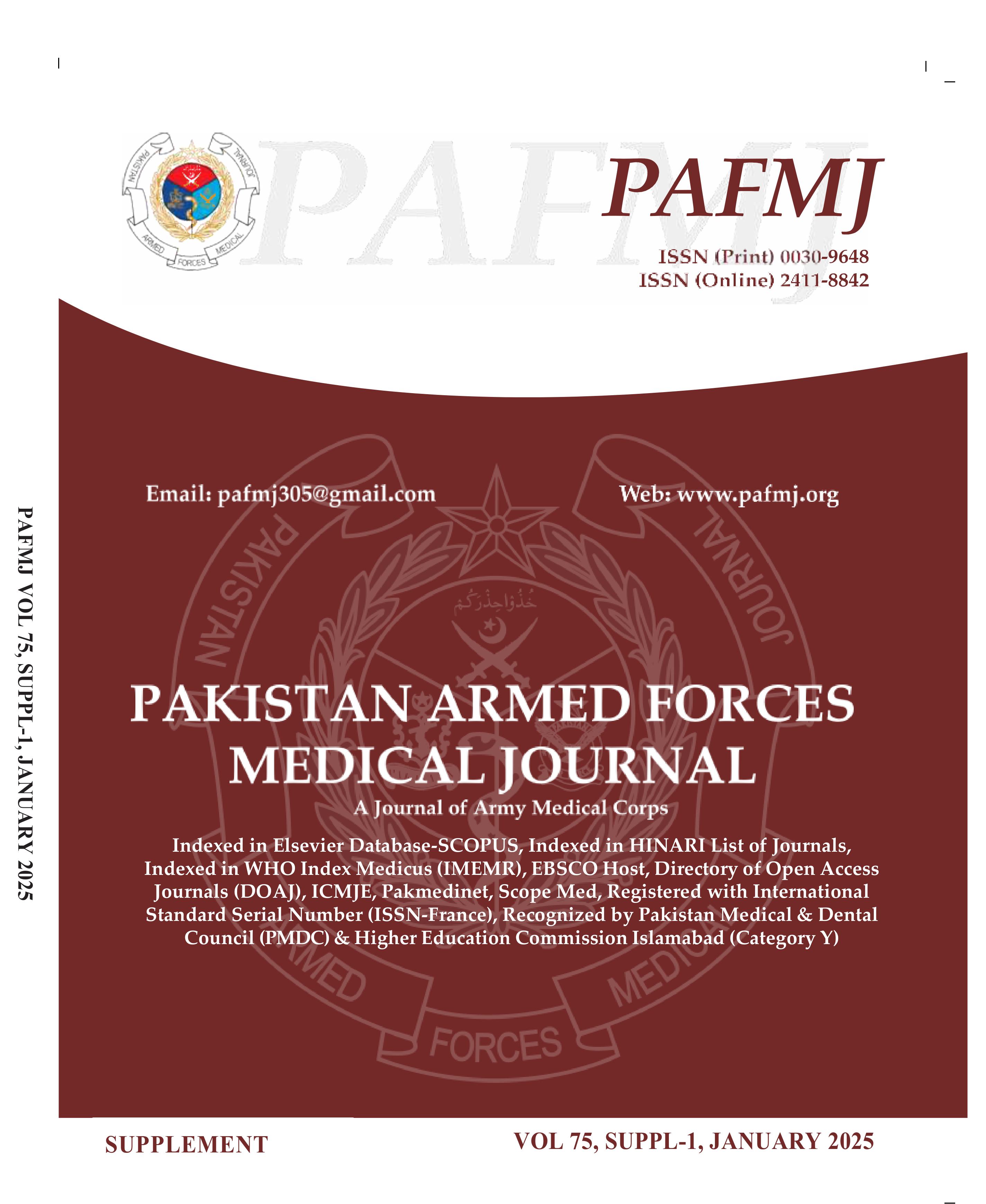Factors Associated with Breast Cancer Risk According to Tumor Subtypes: Triple Negative Breast Cancer vs. NON-Triple Negative Breast Cancer Among Women in Karachi, Pakistan
DOI:
https://doi.org/10.51253/pafmj.v75iSUPPL-1.6565Keywords:
Breast cancer, socioeconomic status, triple negative, vitamin D deficiencyAbstract
Objective: To evaluate risk factors associated with triple negative breast cancer among women in Karachi Pakistan
Study Design: Multicenter hospital-based case control study
Place and Duration of Study: Aga Khan University Hospital and Karachi Institute of Radiation & Nuclear Medicine Karachi, Pakistan from February 2015 to July 2018.
Methodology: There were three hundred and eighty cases of breast cancer patients who had complete molecular profiling and who were compared with 798 controls and in person interviews were conducted.
Results: The multivariable multinomial logistic regression analyses showed that both triple negative breast cancer and non- triple negative breast cancer subtypes were associated with poor socioeconomic status and low Vitamin D concentrations with triple negative breast cancer risk much higher among women of low socioeconomic status (OR=8.76, 95% CI= 2.45, 31.32) and women with vitamin D deficiency (OR=3.11, 95%CI= 1.17. 8.29).
Conclusions: Correction of Vitamin D deficiency in women maybe a possible cost-effective strategy to prevent triple negative breast cancer like aggressive breast cancer. It should be further tested though cohort studies or clinical trials in our population.
Downloads
References
McPherson K, Steel CM, Dixon JM. ABC of breast diseases. Breast cancer-epidemiology, risk factors, and genetics. BMJ. 2000; 321(7261): 624-8.
Perou CM, Sorlie T, Eisen MB, van de Rijn M, Jeffrey SS, Rees CA, et al. Molecular portraits of human breast tumours. Nature. 2000; 406(6797): 747-52.
Singh R, Gupta S, Pawar SB, Pawar RS, Gandham SV, Prabhudesai S. Evaluation of ER, PR and HER-2 receptor expression in breast cancer patients presenting to a semi urban cancer centre in Western India. J Cancer Res Ther. 2014; 10(1): 26-8.
Holm J, Eriksson L, Ploner A, Eriksson M, Rantalainen M, Li J, et al. Assessment of Breast Cancer Risk Factors Reveals Subtype Heterogeneity. Cancer Res. 2017; 77(13): 3708-17.
Lara-Medina F, Perez-Sanchez V, Saavedra-Perez D, Blake-Cerda M, Arce C, Motola-Kuba D, et al. Triple-negative breast cancer in Hispanic patients: high prevalence, poor prognosis, and association with menopausal status, body mass index, and parity. Cancer. 2011; 117(16): 3658-69.
Anderson KN, Schwab RB, Martinez ME. Reproductive risk factors and breast cancer subtypes: a review of the literature. Breast Cancer Res Treat. 2014; 144(1): 1-10.
Sisti JS, Collins LC, Beck AH, Tamimi RM, Rosner BA, Eliassen AH. Reproductive risk factors in relation to molecular subtypes of breast cancer: Results from the nurses' health studies. Int J Cancer. 2016; 138(10): 2346-56.
Hammond ME, Hayes DF, Wolff AC, Mangu PB, Temin S. American society of clinical oncology/college of american pathologists guideline recommendations for immunohistochemical testing of estrogen and progesterone receptors in breast cancer. J Oncol Pract. 2010; 6(4): 195-7.
D.W. Hosmer SL. Applied Logistic regression. third ed. Sons JW, editor. United States of AmericaISBN: 978-0-470-58247-3.
Hosmer D. Applied Logistic Regression. Second Edition ed.
Lehmann BD, Bauer JA, Chen X, Sanders ME, Chakravarthy AB, Shyr Y, et al. Identification of human triple-negative breast cancer subtypes and preclinical models for selection of targeted therapies. J Clin Invest. 2011; 121(7): 2750-67.
John EM, Hines LM, Phipps AI, Koo J, Longacre TA, Ingles SA, et al. Reproductive history, breast-feeding and risk of triple negative breast cancer: The Breast Cancer Etiology in Minorities (BEM) study. Int J Cancer. 2018; 142(11): 2273-85.
Vona-Davis L, Rose DP, Hazard H, Howard-McNatt M, Adkins F, Partin J, et al. Triple-negative breast cancer and obesity in a rural Appalachian population. Cancer Epidemiol Biomarkers Prev. 2008; 17(12): 3319-24.
Sajid MT, Ahmed M, Azhar M, Mustafa QU, Shukr I, Ahmed M, et al. Age-related frequency of triple negative breast cancer in women. J Coll Physicians Surg Pak. 2014; 24(6): 400-3.
Sandhu GS, Erqou S, Patterson H, Mathew A. Prevalence of Triple-Negative Breast Cancer in India: Systematic Review and Meta-Analysis. J Glob Oncol. 2016; 2(6): 412-21.
Phipps AI, Chlebowski RT, Prentice R, McTiernan A, Wactawski-Wende J, Kuller LH, et al. Reproductive history and oral contraceptive use in relation to risk of triple-negative breast cancer. J Natl Cancer Inst. 2011; 103(6): 470-7.
Parise CA, Caggiano V. Risk factors associated with the triple-negative breast cancer subtype within four race/ethnicities. Breast Cancer Res Treat. 2017; 163(1): 151-8.
Banegas MP TL, Altekruse S, Anderson WF, John EM, Clarke CA. Heterogeneity of breast cancer subtypes and survival among Hispanic women with invasive breast cancer in California. Breast Cancer Res Treat. 2014; 144(3): 625-34.
Anders C, Carey LA. Understanding and treating triple-negative breast cancer. Oncology (Williston Park). 2008; 22(11): 1233-9; discussion 9-40, 43.
Fatima F, Hameed A, Haider G, Zehra S, Azhar A, Saleem S. Association and implications in triple negative and triple positive breast cancer: Relationship with sociodemographic and reproductive factors in Pakistan. Pak J Med Sci. 2018; 34(6): 1468-72.
Millikan RC, Newman B, Tse CK, Moorman PG, Conway K, Dressler LG, et al. Epidemiology of basal-like breast cancer. Breast Cancer Res Treat. 2008; 109(1): 123-39.
Rainville C, Khan Y, Tisman G. Triple negative breast cancer patients presenting with low serum vitamin D levels: a case series. Cases J. 2009; 2:8390.
LaPorta E, Welsh J. Modeling vitamin D actions in triple negative/basal-like breast cancer. J Steroid Biochem Mol Biol. 2014; 144 Pt A: 65-73.
Downloads
Published
Issue
Section
License
Copyright (c) 2025 Uzma Shamsi, Azra Shamsi, Shaeryar Usman

This work is licensed under a Creative Commons Attribution-NonCommercial 4.0 International License.















